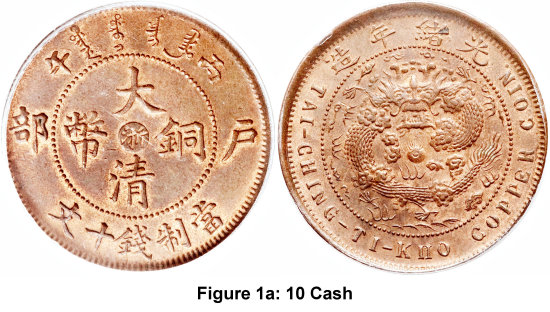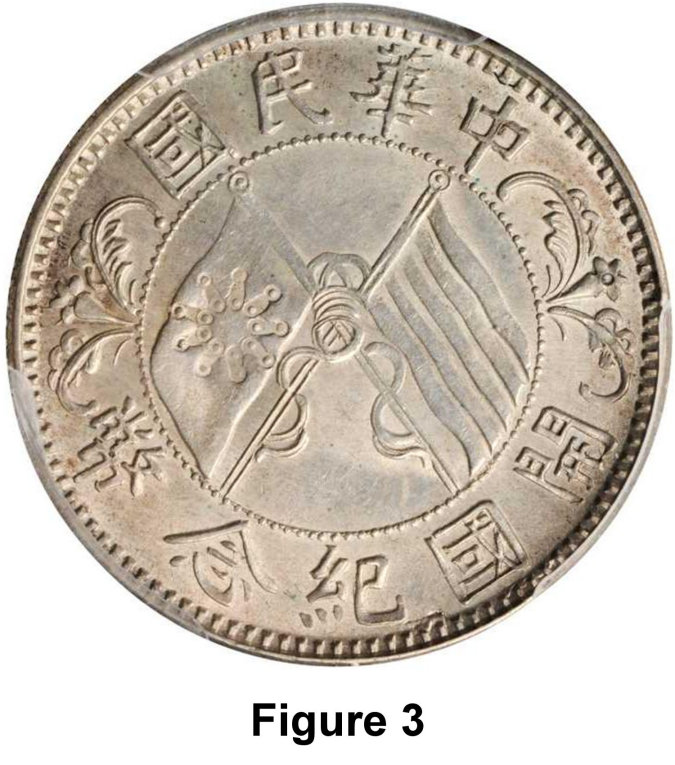Part 1 - The Ch'ing Dynasty
The very simple history is that in 1911 the Ch'ing Dynasty was overthrown because of the Xinhai Revolution and the Republic of China was founded. The coins shown in Figure 1a and 1b are 10 cash 20 cash coins
from the Ch'ing Dynasty.
Cash in this case is equivalent to our 1 cent so a 10 cash coin is equivalent to 10 cents. The first thing to notice is the dragon on the reverse which is a representation of Imperial China.
The second thing is on the obverse in the centre is the issuing mint's mint mark which has four characters around the mint mark. The two vertical characters represent the emperor while the two horizontal characters
denote Imperial China.
Once the Ch'ing dynasty fell and Republic of China was being established there was a power vacuum in which a number of warlords began to rise up. These warlords are ex-army generals who simply failed, against the
Guomindang or the Nationalist Party, to gain power. In the midst of all this the Communist Party got its start in 1921. The Communist Party had initial support from Russia in the form of money, arms and some
Russian party officials. The initial concentration of power for the Chinese Communists was in the northern parts of the country due to its proximity to Russia but also because the communist message appealed to
the poorer rural people.
By the early 1930's the Nationalist Party had a wider authority partly due to having a larger number of the warlords on their side which was a direct result of both bribery and military action.
This did not mean that some warlords changed sides especially if the bribe or other incentive received was greater than what had been received or promised from the other side.
Even though the Nationalist Party was in control of most of the country despite a variety of different factions, they had a much tougher time trying to defeat the communists because they had a very strong
political and ideological belief. This combined with the fact that the communists were not concentrated in the built up areas, which were controlled for the most part by the Nationalist Party, made them
much more difficult to control and defeat.
Added to all of this you then have the foreign influence and intervention by countries such as Britain, Russia, the U.S., and Japan. This is not the place to explain all of this other than to say that
Britain and the U.S. were supporting the Nationalist Party in the hopes of limiting both the expansion and influence of Communism as well as Japan's expansion through its war with China.
Part 2 - The Japanese Invasion
This may surprise a few people but the U.S. was technically at war with Japan before Dec. 7, 1941 through a small group called the American Volunteer Group.
This was a group of ex-U.S. airforce pilots who were employed by the Chinese Nationalist Government as mercenaries to fly the American made P-40 Warhawks.
In fact John Wayne was the star of a movie about the AVG called "The Flying Tigers".
Russia on the other hand was supporting the Chinese communists which included invading northern China to not only fight the Japanese but to give themselves a a buffer zone in case the Japanese turned north.
During the 1930's there was some direct conflict between the Nationalists and the Communists but when Japan invaded they came together to fight the common enemy. Generally, the Nationalists fought a
frontal war against the invading Japanese while the Communists conducted guerilla warfare along the Japanese lines of communication. After WWII the two sides were back fighting each other with the
Communists eventually prevailing in 1949 with China becoming a Communist state.
As mentioned before we do not have time to look at every coin and the changes involved so we will look at a few specific examples of the smaller denominations. When you compare the coins from Part 1
to the silver one in Figure 2 you will notice that the dragon has been replaced by the simple numerical value of the coin. On the obverse you will notice that
there are still four Chinese characters. The top and bottom character are the number 2 and the word "jiao" meaning 20 cents while the two horizontal characters are currency and silver.
Also in use at the time were copper 10 cash and 20 cash coins. On these coins the dragon has been replaced by two crossed flags. There are many different varieties in these coins when
just considering the sash and the knot that ties the two flags together. When looking at the flags the one on the left is common to all types of this coin that I have seen and it is the National
Revolutionary Army flag (1911 to 1928). On the coin the centre of this flag has what looks like a star with each element representing a province of China. There is a variety of different flags on the
right side, in the three examples that we have there are two that show the Five Coloured Flag of the Republic (Figure 3) that has five horizontal stripes each of which represent the five founding people
groups of China while the other coin shows the Shanxi Provincial flag (Figure 4).
As for the other denominations of coins, they also went through similar changes as the Dragon motif was dropped after 1911 along with the script on the coins changing. There is also two other types
of coins that were introduced between 1911 and 1949:
- The first is the warlord currency (Figure 5) which features reversed English writing. Some people consider this material to be contemporary counterfeit.
This warlord currency also included paper scrip and was produced in such huge quantities in order to pay their troops that it led to very high rates of inflation.
Note: the photo in Figure 5 is a reversed picture to show what is illustrated in the 2011 Catalogue of World Coins and is not a picture of an actual specimen.
- The second was the occupation currency introduced by the Japanese (Figure 6).
Part 3 - The Rise of Communism
During the 1930's many mints in China closed their doors but once China became a communist state in 1949 only the mints that were actually required to produce enough coins for use in China remained open.
Even though the Communist government issued paper currency in 1949 the first coins issued by the Chinese Communist government did not come out until 1955. One other thing that happened was that the Communist
government renamed the Yuan to the Renminbi which is the official name and means "the people's currency". However, the Yuan still remained as the name for a unit of the renminbi currency.
So for example something may cost 20 Yuan but it would be incorrect to say that it cost 20 Renminbi.
In 1955 and 56 when the new coinage (such as the 1, 2 and 5 Fen coins shown in Figure 7) was issued by the Communist government it became standardized with the national emblem that has 7 Chinese
characters around the top of the emblem that says "The Peoples Republic of China". The reverse of the coin has its value along with the date. The other change that occurred was that the smaller
denominations were all minted in aluminum as opposed a variety of metals such as silver, copper, bronze and aluminum that were used before the Communist era.
So in the years between the end of the Ch'ing Dynasty there were huge changes in the political landscape which was then reflected in the coins that were issued by the respective governments.
I realize that this is only a very brief look at the subject and in no way is meant to be comprehensive and is meant only to highlight a few examples.
|








